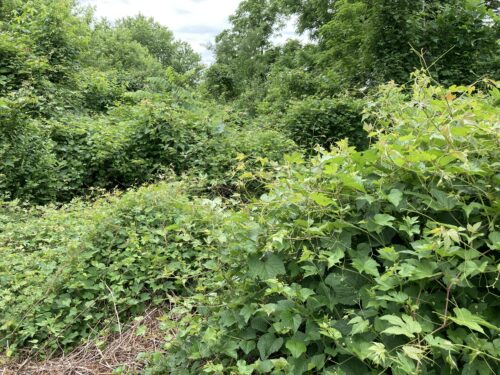A New Invasive in Town By Julie Sullivan GoNativeLI.com
From HOBAS Newsletter Article
If you’ve ever driven through the South you likely encountered miles of green mounds hiding trees, shrubs and even cars and structures. It is known as Kudzu — The Vine That Ate The South. Now imagine a vine just like Kudzu invading Long Island. It’s called Porcelain-berry, Ampelopsis brevipedunculata, and although prohibited from sale in New York State, it is exploding from existing plants in many of our backyards, parks and abandoned properties.
This vine was introduced to the US east coast from Asia/Siberia as an ornamental plant for its attractive berries, which ripen from green to white, pink, lavender, turquoise, and finally blue and black from late September through October. The leaves are often mistaken for grape leaves, but differ from them by their glossy undersides.
These invasive climbers, working their way through trees with their zigzag vines, are harmful to the ecosystem (the interaction between plants, animals and the environment), since they have no natural predators or diseases outside their homeland, aggressively out-competing native plants for water, nutrients and especially light. Consequently, once trees are hidden from sight, the bees, butterflies, and birds that evolved along with our native plants can no longer access their intended nutrient-rich food.
Porcelain-berry vines climb by their twining tendrils that are so tenacious they must be cut when anyone attempts to pull them from their supporting trees, shrubs, herbaceous plants, and even tall grasses. During the spring and summer, control these vines by hard-pruning, removing seedlings, and cutting and digging out established root crowns. Each crown supports an average of five vines above ground and several lateral, knotty roots, easily pulled out when cut or sawed at the crown. Once berries appear, remove and securely bag/dispose of them, including all berry-laden vines. Be sure to protect the native plants growing beneath, and because the vines hide multi-flora rose shrubs, wear leather work gloves — welding gloves are even better — and cut them at the ground.

Visit GoNativeLI.com/porcelain-berry to identify methods for removal.
And to see a recent infestation visit GoNativeLI.com/Restoration.
